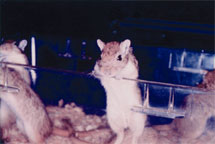 |


Fig.2: Gerbil having an epileptic seizure |
|
Last March, up until the evening before I was to leave for the Institute of Physical and Chemical Research, I was studying gerbils as model animals for epilepsy research at the Institute for Developmental Research in Aichi Prefecture. Gerbils are rodents, somewhere in between rats and mice in size (Fig.1). They were brought to Japan from the area around the Amur River in the nineteen-fifties, and spread from Japan to research institutes in America and then to Europe. Gerbils are really cute, good-tempered, and full of curiosity, making them ideal for me. However, some of them suffer from epileptic type seizures. (Fig.2). I discovered a simple method of stimulation that would induce seizures, and then created a strain of gerbils susceptible to seizures by brother-sister mating. This allowed me to study seizures that increase in severity as they develop. Starting about 40 days after birth, their ears begin to move repeatedly immediately after stimulation. This characteristic movement resembles the movements that occur if inhibition of somatosensory cortex is suppressed. Eventually the same stimulation causes movements of the eyes and heads, finally leading to generalized seizures.
They develop a tendency to have seizures under psychological stress. When one of these gerbils is placed on top of its cage, it will immediately go to the edge and look over to see if it can get down. When it realizes the drop is too great, it will run to the other side to try there. As the gerbil realizes that it can't get off the cage because it's too high, it has a seizure.
Dr. Yoshiya Murashima of the Tokyo Institute of Psychiatry, from the group that originally created this strain, also created a strain that is resistant to seizures, even when stimulated. When one of these gerbils is placed on the lid of its cage, it also will go to the edge to judge the height, but when it realizes that it cannot descend, it does not have a seizure. Advised by Dr. Shigeyoshi Itohara, Head of the Laboratory for Behavioral Genetics, where I now work, and by Dr. Kazuhiro Yamakawa, Head of the Laboratory for Neurogenetics, I created F1 hybrids of both strains. In the F1 hybrids, stimulation appeared to induce the early stage movements, but the change to generalized seizures was delayed. We are studying candidate proteins for genetic factors, and have found differences in one of the mitochondria proteins of the two strains. We are now searching for someone to conduct research on the two strains.
Recently, I talked to a Korean researcher, and it appears that the difficulty of obtaining research subsidies for epilepsy research may be a worldwide problem. I even know some researchers who have withdrawn from epilepsy research because they could not get grants. One reason may be a lack of awareness of the prevalence of epilepsy. Epilepsy syndrome is the repeated occurrence of an abnormal electrical discharge in the cerebral cortex, and the symptoms vary widely depending on the pattern and location of the abnormal discharge, and on the frequency of seizures. It has been reported that there are more than 1 million people (approximately 1 in every 100 people) suffering from epilepsy in Japan. Because it also occurs as a consequence of injuries sustained in traffic accidents, it is an extremely common problem. I suspect that the simultaneous, rhythmic discharge of many nerve cells seen in epileptics is an inescapable fate for an animal with a nervous system that uses that same phenomena for normal function. But we must not treat it lightly because it causes such severe problems for so many people. For example, not just severe generalized seizures, but abnormal brain waves occurring at a rate of 3 per second can render a person unconscious, which can result in accidents. The automatic behavior caused by epileptic seizures is sometimes mistaken for shoplifting. This behavior is actually purposeless, since the person is unconsciousness, but in some cases, appears to be purposeful. There are children who cannot go out to play because flashing lights cause spasms. Treatment methods including new medicines as well as social support systems must be developed as quickly as possible to help them to lead normal lives and to participate in society.
There are many problems caused by epilepsy. As I read the journal of the Nami no kai,* (an organization of epileptic people, their families, doctors and others who assist them), or talk to acquaintances who ask me for advice, I hope that we can solve these problems by approaching them from a variety of perspectives.There are engineering based methods of treatment such as developing eyeglasses to block the frequencies that induce seizures. In the natural sciences, epilepsy is closely related to the foundations of brain research, so I am reassured that BSI, with its specialty in brain research, is also conducting research on epilepsy. I was told by some of the participants in the epilepsy session at the BSI international symposium held in late 2002 that they understood the situation for the first time. Last year, my husband talked about epilepsy in his social welfare class. I would be delighted if students who learn about it from him become interested in tackling the problem as a social issue. I would be delighted if you who have now read this letter to the end are also inspired to help epileptic people.
* The Nami no kai (The Japanese Epilepsy Association. Int.) is a member of the International League Against Epilepsy. It publishes a monthly journal, holds seminars as well as many other activities. The Saitama prefecture branch holds its own additional activities, including peer counseling. |
 |
 |
|
|
|






